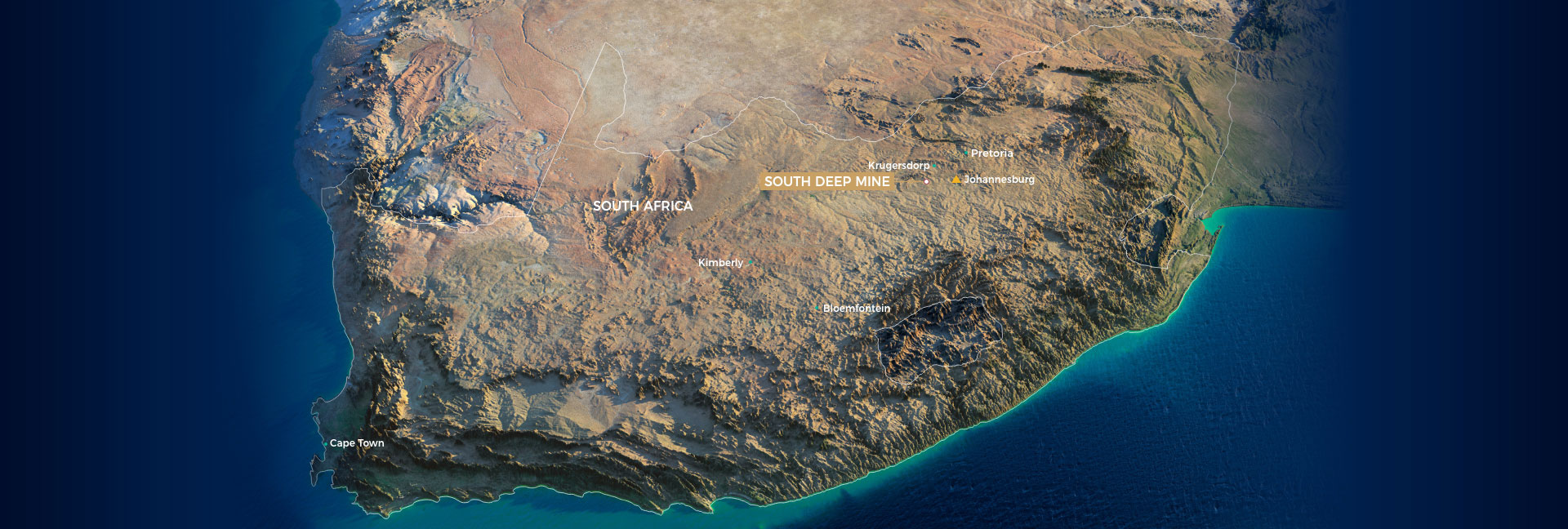OPERATIONS ![]() South Africa Region
South Africa Region

| SOUTH DEEP | ||||
| Mining method | South Deep is an underground bulk mechanised mine that employs both full-time workers and contractors. To manage rock stress and seismic activity, reserves are accessed through access development, destress, and shadow development cuts. A few selective mining methods, such as drifts and benches, are used, but the primary bulk mining method is long-hole stopping with back fill. The mining process and extraction procedure are being optimised. | |||
| Mining operational infrastructure | The workings are accessed from the surface via two shaft systems: the Twin Shaft complex (main and ventilation shafts), of which the main shaft is a single drop to 110A level at a depth of 2,998m, and the vent shaft is a sub-vertical system (three operating shafts) to 95 level at a depth of 2,786m. The mine is divided into three main areas:
|
|||
| Mineral processing and TSFs |
A traditional SAG/ball milling circuit, a gravity gold recovery circuit, and a conventional CIL/CIP circuit comprise the South Deep processing facility. The gravity and CIP circuits' output is melted into doré bars for refining at Rand Refinery.
The South Deep plant additionally contains a tailings re-treatment section that comprises of a thickener followed by a specialised CIL circuit for tailings re-treatment. South Deep has one active TSF, Doornpoort TSF, and four dormant TSFs, TSF 1, 2, 3, and 4. TSF 2 is being re-mined utilising hydraulic mining techniques and a water cannon. To date, the top half of TSF 1 has also been re-mined. TSFs 1 and 2 were built in 1968 and functioned as upstream raised paddock dams. These TSFs have a total footprint of 69ha and a maximum height of 47m. TSFs 3 and 4 were built in 1982, and they are likewise upstream elevated paddock dams. These TSFs have a total footprint of 100ha and a maximum height of 41m. In 2011, deposition on these TSFs halted. The Doornpoort TSF was completed in April 2011, and three upstream wall rises were built. The Doornpoort TSF has a gravity decant system as well as drainage systems beneath the tailings. This facility has 149Mt of remaining LoM storage capacity (phase 2). |
South Deep is a flagship asset for Golden Mine Projects that has the potential to unlock enormous value. In 2021, the mine will continue to incorporate improvements and maintain traction on the strong productivity trends that are supporting the ramp-up.
Despite three waves of Covid-19-related interruptions, key performance parameters improved significantly in 2021. The amount of ore extracted grew by 36% to 1,540kt in 2021, up from 1,136kt in 2020. Similarly, due to increasing volume, gold production climbed by 29% in 2021 to 9,102kg (292,634oz) from 7,056kg (226,900oz) in 2020.
The productivity improvement initiative implemented in 2019 is producing long-term results. This has been reinforced by the implementation of an operational model that will allow the company to run at the appropriate level, develop process capabilities, and assure process stability. This will improve planning, execution, and work management, as well as overall performance. These enhancements are in keeping with the mine's production ramp-up strategy, which calls for a steady-state yearly output of 12 tonnes of gold.
Salient features
| Mineral Resources | Mineral Reserves | |
|---|---|---|
| 61.2Moz* | 32.2Moz* | |
| (-2% NET OF DEPLETION) | (-7.6% NET OF DEPLETION) |
* 90.538% attributable to Golden Mine Projects (life-ofmine (LoM) 2020)